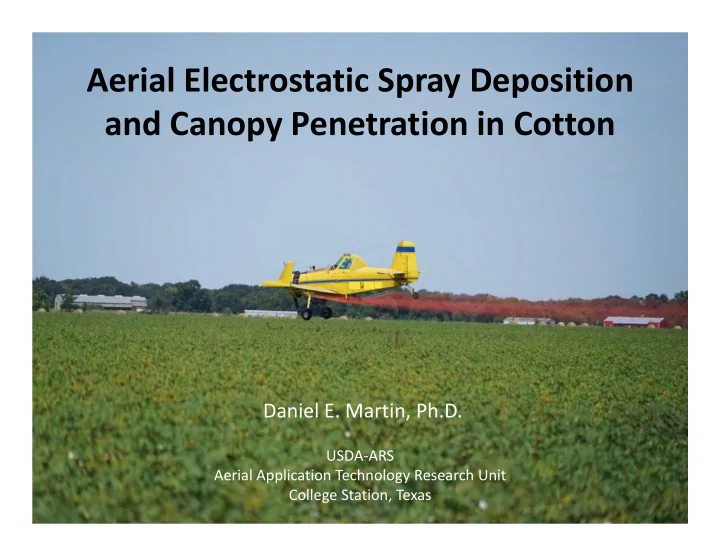

Aerial Electrostatic Spray Deposition and Canopy Penetration in Cotton Daniel E. Martin, Ph.D. USDA ‐ ARS Aerial Application Technology Research Unit College Station, Texas
Electrostatic Deposition and Penetration • Objective: Determine if electrostatically charging an aerial spray could increase deposition and penetration of that spray in late season field cotton: – DayGlo Rocket Red Dye – Mature Cotton Field – Spraying Water and 10% v/v Dye – Commercial Aerial Applicator – Air Tractor 301A
Rocket Red DayGlo Fluorescent Dye
Rocket Red DayGlo Fluorescent Dye
Electrostatic Nozzles
Electrostatic Deposition and Penetration Anticipated Outcome: Scientific documentation of the deposition and penetration capabilities of the aerial electrostatic system.
Study Field Burleson County, Texas 165 Acres
Study Field 600’
Treatments Treatment Nozzle Charge Application Rate (GPA) 1 Electrostatic Off 1.0 2 Electrostatic On 1.0 3 Rotary Atomizer Off 3.0 ‐ 60 Leaf samples from each treated area (10 Top Canopy, 10 Mid Canopy) ‐ 30 Water Sensitive Paper samples from each treated area
Field Application
Field Application Video
Field Application Video
Water Sensitive Papers
Leaf Processing
Leaf Processing
Fluorescent Imaging
Fluorescent Imaging
Leaf Area Measurements
Image Processing – Leaf Top
Image Processing – Leaf Bottom
Thresholded Image – Leaf Top
Selected Image– Leaf Top
Drawings – Leaf Top
Summary – Leaf Top Slice Count Total Area Average Size %Area Mean T2R1T ‐ 8T.JPG 3287 10276 3.126 0.028 26.76
Volumetric Median Diameter Water Sensitive Papers 210 203 202 No Charge Charged Rotary Atomizer
Application Rate Water Sensitive Papers 0.359 0.254 0.258 Rotary Atomizer No Charge Charged
Number of Droplets Water Sensitive Papers 358 239 220 No Charge Charged Rotary Atomizer
Droplet Density Water Sensitive Papers 18.5 12.4 11.4 No Charge Rotary Atomizer Charged
Droplet Density by Canopy 44.9 Mid Top 39.2 19.4 10.9 8.8 7.8 No Charge Charged Rotary Atomizer
Droplet Density – Top Canopy – Cotton Leaves 83.6 59.7 32.0 18.8 6.8 6.3 Charged Rotary Atomizer No Charge
Droplet Density – Mid Canopy – Cotton Leaves 20.4 15.7 13.5 1.9 1.7 1.5 Rotary Atomizer No Charge Charged
Conclusions • DayGlo fluorescent dye is a very good tracer for determining spray deposits in field cotton. • The fluorescent imaging technique using ImageJ is a very good and objective measure of spray deposits for both bottom and top leaf surfaces. • Spray droplet density in the top of the cotton canopy was higher than that of the mid canopy. • Spray deposits on the top of the leaves was higher than on the bottom of the leaves.
Conclusions • Electrostatically charging the aerial spray increased spray deposits on both leaf surfaces in the top canopy compared to the uncharged spray. • All tested spray treatment resulted in equal canopy penetration (mid canopy deposits). • The electrostatically charged spray at 1 GPA had equivalent top canopy top leaf deposits as the 3 GPA application. • Charging the spray resulted in 3 times as many deposits of the underside of the leaves compared to the uncharged and RA sprays.
Recommend
More recommend